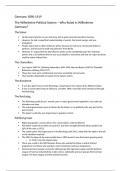Germany 1890-1919
The Wilhelmine Political System – Who Ruled in Wilhelmine
Germany?
The Kaiser
He had some talents; he was charming, had a quick mind and excellent memory.
However, he had a superficial understanding of events, had mood swings, and was
prejudiced.
People argue that he didn't influence policy because he had many ceremonial duties to
perform, and because he took long absences from Berlin.
However, it's argued that he did influence policy as the constitution gave him supreme
power, and as he believed that he was accountable to God alone and that no major decisions
could be taken without him.
The chancellors
Leo Caprivi 1890-94; Chlodwig Hohenlohe 1894-1900; Bernard Bulow 1900-09; Theobold
Bethmann-Hollweg 1909-1917.
These four men were not Bismarck and were essentially civil servants.
Their position depended on loyalty to the kaisers whims.
The Bundesrat
It was the upper house in the Reichstag, comprising of men chosen from different states.
It was a conservative body of influence, and after 1890, most bills were introduced through
the Reichstag.
The Reichstag
The Reichstag could discuss, amend, pass or reject government legislation, but could not
introduce any laws.
The actual government were all chosen by the Kaiser, so no political party was part of the
government.
The kaiser's authority was impervious to popular control.
Political groups
Right wing parties: conservatives, free conservatives, national liberals.
The Kaiser could rely on them to back him, but their strength declined (these parties had
26% of the vote in 1912).
The centre party: the largest party in the Reichstag until 1912, sided with the right or the left
as the situation required.
The SPD: the lapse of the anti-socialist law in 1890 meant it was the fastest growing party.
o In 1912 it was the largest party.
There was a split in the SPD between those who wanted to follow a radical Marxist
programme and those who wanted a more moderate minimum programme.
Interest/pressure groups: economic lobby groups (the Agrarian League and the National
League of German Industrialists), trade unions, nationalist pressure groups (Pan-German
League, the Navy League and the Colonial Society).
, These were a symptom of increased political participation.
The States
There were 25 federal states, but authority was becoming more centralised. Social insurance
schemes, tariffs, etc, were all Reich issues.
Urbanisation, better communications and influence of education and military service were
eroding provincial identity and creating a German one.
Prussian dominance continued:
o All chancellors (apart from Caprivi) were also Prussian MPs.
The Army
Bismarck successors found it difficult to stand up to the military chiefs, who mostly had
Wilhelm’s support.
By 1914 the army wasn't as dominated by Prussia – the officers came from the middle class.
But, the high-ranking officers were aristocrats and the bourgeois officers imitated their
betters.
The army looked down on civilians, and civilians looked up to military virtues in the army as
an institution.
o Army had onto social importance.
The army remained a reactionary barrier to modernisations.
Economic, Social and Intellectual Trends
Intellectual Trends
Growth of Right-wing intellectual movements: Nationalism
By 1900, nationalism was unrecognisable from its progressive, liberal guise.
Most nationalists were now conservative, wanting to maintain the status quo in a militarised
Germany.
But new ideas were breeding contempt for other races (especially the Slavs). This led to the
wish to create an ethnically and linguistically homogeneous state.
There was some discrimination against Germany’s minorities: Poles (5% of population,
French, Danes.
Prussia legislated against the Polish language – this strengthened Polish nationalism, leading
to a mass strike by 40,000 Polish school children in 1906.
Antisemitism
Historic anti-Semitism had been religious – jews were blamed for the death of Christ.
Whilst it didn't disappear, anti-Semitism was politically insignificant by the mid-19th century.
By 1871, the Jews of the German empire had total civil equality.
In the 19th century, thousands of Russian Jews fled persecution to Germany.
Many of these jews prospered, becoming doctors, bankers, lawyers and academics.
By 1900, most saw themselves as German first and Jewish second.
By 1910, there were 600,000 practising Jews, which made-up about 1% of the German
population.




